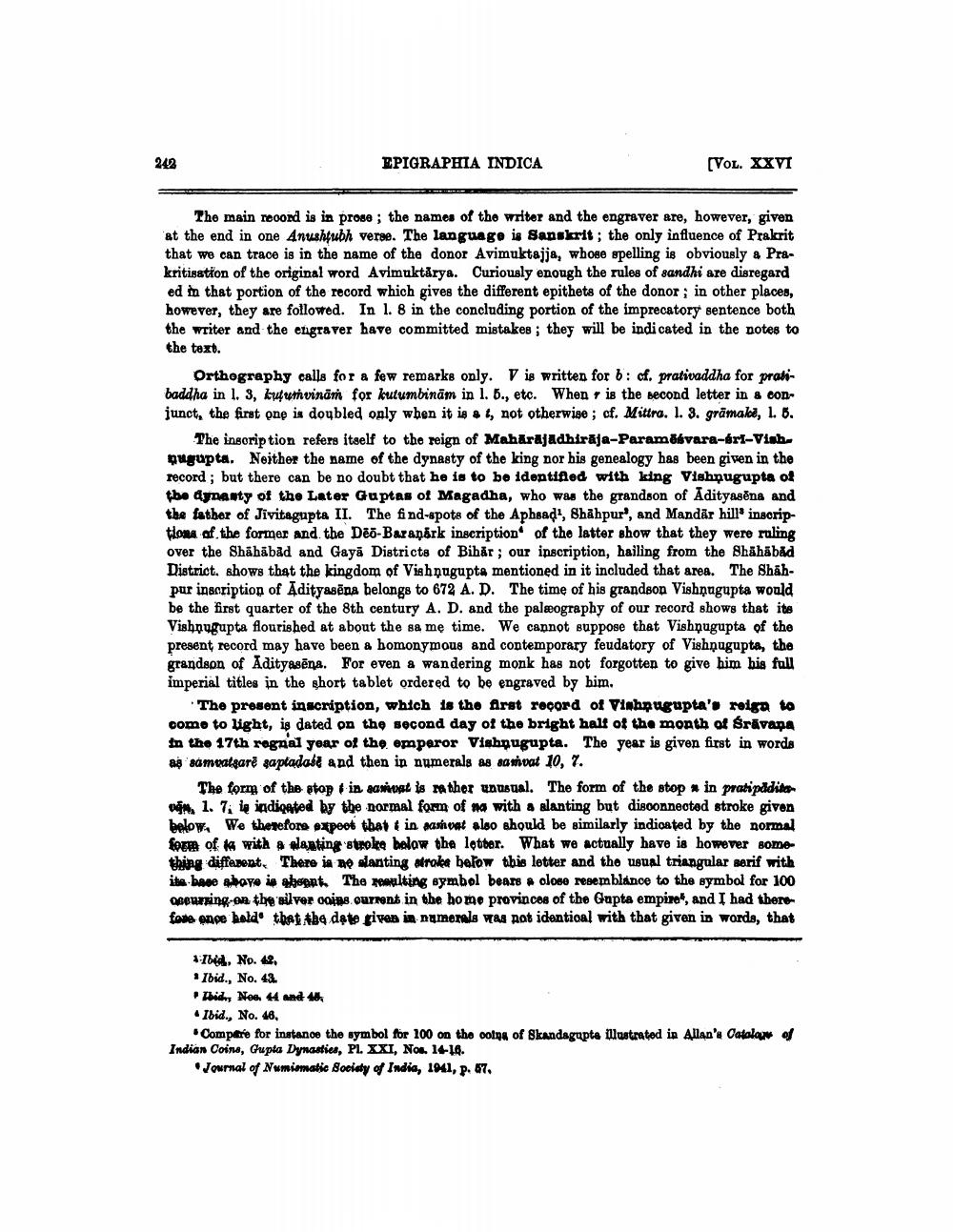________________
242
EPIGRAPHIA INDICA
(VOL. XXVI
The main record is in prose; the names of the writer and the engraver ere, however, given at the end in one Anushtubh verse. The language is Sapskrit; the only influence of Prakrit that we can trace is in the name of the donor Avimuktajja, whose spelling is obviously & Prekritisation of the original word Avimuktarya. Curiously enough the rules of sandhi are disregard ed in that portion of the record which gives the different epithets of the donor; in other places, however, they are followed. In 1. 8 in the concluding portion of the imprecatory sentence both the writer and the engraver have committed mistakes ; they will be indicated in the notes to the text.
Orthography calls for a few remarks only. V is written for b: cf. prativaddha for pratibaddha in I. 3, kutumvinär for kutumbinām in l. 5., etc. When is the second letter in & conjunct, the first one is doubled only when it is & l, not otherwise ; of. Mittra. 1. 3. grāmake, 1. 8.
The inscription refers itself to the reign of Maharajadhiraja-Paramasvara-bri-Vishpugupta. Neither the name of the dynasty of the king nor his genealogy has been given in the record; but there can be no doubt that he is to be identified with king Vishnugupta of the dynasty of the Later Guptas of Magadha, who was the grandson of Adityasēns and the father of Jivitagupta II. The find-spots of the Aphead', Bhahpur', and Mandār hill' insoriptions of the former and the Deo-Baranark inscription of the latter show that they were ruling over the Shāhābad and Gayā Districts of Bihăr, our inscription, hailing from the Shāhābåd District. shows that the kingdom of Vishnugupta mentioned in it included that area. The Shāhpur inscription of Adityasēna belongs to 672 A. D. The time of his grandson Vishnugupta would be the first quarter of the 8th century A. D. and the palæography of our record shows that its Vishnugupta flourished at about the same time. We cannot suppose that Vishnugupta of the present record may have been a homonymous and contemporary feudatory of Vishnugupta, the grandson of Adityasēna. For even a wandering monk has not forgotten to give him his full imperial titles in the short tablet ordered to be engraved by him.
The present inscription, which is the first record of Vinhpugupta's reign to come to light, is dated on the second day of the bright halt of the month of Srāvana In the 17th roghal year of the emperor Vishnugupta. The year is given first in words as 'samvatsarë saptadast and then in numerals as sanoat 10, 7.
The form of the stop in sawiwat is rather unusual. The form of the stop * in pratipdchita vom 1. 7. le indicated by the normal form of ma with a slanting but disconnected stroke given below. We therefore expeof that in masivat also should be similarly indioated by the normal form of a with a wanting stoke below the letter. What we actually have is however some thing different. There is no wanting sroka below this letter and the usual triangular serif with ite have above is aboant. The multing symbol bears close resemblance to the symbol for 100 aneurring on the silver coins ournent in the home provinces of the Gupta empire, and I had there fone once held that the date given in numerals was not identioal with that given in words, that
*Ibid, No. 42. * Ibid., No. 43. Poids Nee 44 and 4 Ibid., No. 48,
Compare for instance the symbol for 100 on the colpa of Skandegupta illustrated in Allan'a Catalan of Indian Coina, Gupta Dynasties, Pl. XXI, No. 14-14.
Journal of Numismatic Socidy of India, 1941, p. 67,




